A NEW COLLECTION AND FASCINATING AT THAT
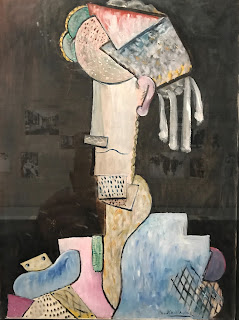 |
| Paul Guillaume (1891-1934) The Dictator -1929 |
 |
| Renoir (1841-1919) Portrait of young man and young girl - 1875-80 |
« Shojira Ishibashi called his company Bridgestone, a literal translation of his surname: ishi (stone) and bashi (bridge) ».
Obviously he must have wanted to encompass both cultures. European and his own.
It was early in his career that Shojiro Ishibashi (1889-1976), showed a passion for arts, and more particularly Western arts, which he began to collect as of the late 1930s. In 1952 he commissioned the building of a museum at the heart of Tokyo to house his collection. Impressionist pieces as well as Western and Japanese works of modern art. His son and grandson have kept up the tradition and the Ishibashi Foundation has more than 2,600 works today.
During the current renovation work at the museum and while awaiting the completion of the new buildings, the masterpieces of the collection are on display for a unique exhibition in the West. I have been in Tokyo quite a few times since the museum was opened and yet I can’t remember if I visited it or not.
It’s an astonishing collection. Impressionism to western and eastern post-war abstraction, from Monet to Renoir, and from Caillebotte to Cézanne, Matisse, Picasso, Pollock and Shiraga. What I liked about it was that the collection shows a permanent link between the history of modern Japan and Western Art.
The popularity of Japanese art in Europe in the late 19th century is common knowledge. Just think of Van Gogh to start with and other artists who were very fast to follow Japanese trends. It didn’t surprise me at all that the public I saw that day was mainly Japanese.
Less well-known is that Western art (and Impressionism in particular) was equally esteemed among visionary collectors in Japan, including Shôjirô Ishibashi, a businessman who began making extensive acquisitions in the 1930s.
His philanthropic plan, came to fruition with the inauguration of the Bridgestone Museum in Tokyo in 1952. Four years later, he set up the Ishibashi Foundation to ensure the long-term mission of the new museum. As I said earlier, his son and grandson have provided continuity of management to the present day.
An early predilection for yôga painting. That I had remembered as a definition. Resembling the Western art « techniques » « styles »…
He was also interested in the 20’s in contemporary painting and acquired a number of pieces by Shigeru Aoki, one of the most prominent Japanese painters working in the Western style. The influence of European painting can also be seen in the work of Hanjirô Sakamoto and in the famous Black Fan by Takeji Fujishima. I knew both names but had never related them to yôga stye
painting
 |
| Takeji Fujishima (1867-1943) Reminescence of the Tempyo era - 1902 |
 |
| Sôtarô Ysui (1888-1955) Portrait of Mme F: 1939 |
 |
| Tsuguharu Fijita (1886-1968) Still life with cat (1939/40) |
 |
| Takeji Fujishima: Black fan 1908-09 |
 |
| Shigeru Aoki (1882-1911) Sea (1904) I thought it was Monet |
As he wanted these masterpieces to stay in Japan he acquired six Monets, paintings by Sisley, Renoir, Pissarro, Degas, Jean-François Millet, Courbet, Renoir and a Caillebotte was purchased in 2011 by his grandson. The tradition will obviously continue.
 |
| Camille Pissarro (1830-1903) Maubuisson Garden, Pontoise - 1878 |
 |
| Alfred Sisley (1839-1899) Women going to the woods from a village in Marlotte - 1866 |
There was also the post-impressionism period with Cézanne, three Gaugins. A still life with Horse’s Head is influenced by the Japanese culture captivated by French painters…and then suddenly a Gustave Moreau…in a way the collection is very eclectic.
 |
 |
| Gustave Caillebotte (1884-1894) Young man playing the piano - 1876 |
 |
| Paul Gaugin (1848-1903) |
 |
| Paul Cezanne (1883-1906) Bathers resting: 1875-77 |
 |
| Paul Cezanne - Bathers: 1897-1900 |
 |
| Self portrait of Paul Cezanne - 1890-1894 |
 |
| Paul Cezanne: St Victoire moutain and the Black chateau - 1904-1906 |
 |
| Paul Signac (1863-1935) La Rochelle - no date |
 |
| Henri Matisse 1869-1954: Collioure - 1904 |
 |
| Matisse - Nude in the atelier - 1899 |
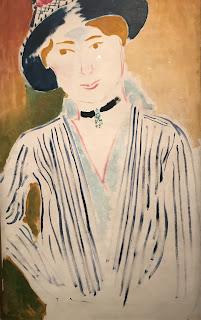 |
| Matisse- The Striped Jacket - 1914 |
 |
| Matisse - Figure with a blue corset -1935 |
 |
| Chaïm Soutine (1893-1943) A large tree in a Midi village - 1924-25 |
 |
| Ossip Zadkine (1890-1967) Torsi 1951 |
 |
| Part of the torsi |
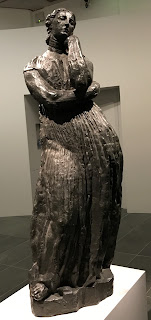 |
| Emile-Antoine Bourdelle (1861-1929) Penelope -1909 |
 |
| Gustave Moreau 1826-1898- La Toilette - 1885-90 |
 |
| Paul Gaugin (1848-1903) Still life and horse's head - 1886 |
 |
| Van Gogh (1853-1890) Windmills and gardens in Montmatre -1886 |
 |
| Edouard Manet (1832-83) The Opera Ball - 1873 |
 |
| Self Portrait Manet 1878-79 |
 |
| Renoir (1841-1919) Melle Georgette Charpentier - 1876 |
 |
| Eugène Boudin (1824-1898) Beach scene near Trouvelle - 1865 |
 |
| Gustave Courbet (1819-1877) - Stag running in the snow - 1856 |
 |
| Honoré Daumier (1808-1879) Don Quichotte & Sancho - 1850 |
 |
| Camille Pissarro (1830-1903) Vegetable garden in Maubuisson 1878 |
 |
| Henri Rousseau (1844-1910) - The pasture 1910 |
 |
| Monet - Sunset in Venise - 1908 |
 |
| Claude Monet - Waterlilies in grey weather - 1907 |
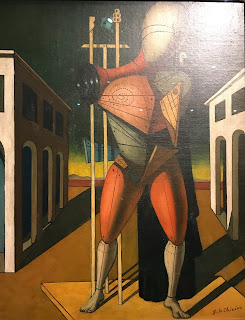 |
| De Chirico (1888-1978) Troubador - date unlnown |
 | |||
| Modigliani (1884-1920) The Young peasant |
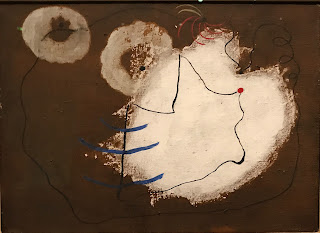 |
| Joan Miro (1893-1983) Painting 1927 |
 |
| Picasso (1881-1973) Corrida - wounded horse 1923 |
 |
| Picasso - Woman's head - 1923 |
 |
| Picasso - Saltimbanque with arms crossed 1923 |
 |
| Picasso - Bourgogne bottle, glass and newspaper -1913 |
Then into another gallery to discover classic modern art. Rodin, Zadkine, and Bracusi’s « The Kiss » which I knew from a book of art but had never seen. This came into his collection in 1988. Obviously when you see it « for real » it is extremely touching not even to mention how sensual a sculpture can become.
 |
| Brancusi (1876-1910) The Kiss - 1907-10 |
Paul Signac, Maurice Denis, Raoul Dufy, Matisse, and later, Rousseau, Soutine, Picasso…and a Modigliani… The Saltimbanque With Crossed Arms, an iconic painting by Picasso, is now a key feature of the museum display.
The collection is rounded off by attempting to trace the history of abstract painting more fully. As a result, we can admire a Mondrian (Pointillist Dune Study) in which the fragmented treatment of the landscape prefigures Paul Klee’s daringly colourful work (Island, 1932).
Kan’ichirô Ishibashi, (his son) was passionate about abstract painting. This is difficult to believe as so many of the Japanese stop with the impressionists. The role played by Hiroshi Ishibashi in assembling this part of the collection is worthy of note. Action painting is exemplified by a Pollock and a work by Hans Hartung, which represent the West, and they are set against art by Shiraga and Zao Wou-Ki.. Lastly, East meets West in paintings by artists such as Soulages and Domoto, which blend references and techniques from both side of the globe.
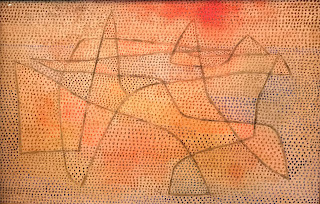 |
| Paul Klee (1879-1940) Island 1932 |
 |
| Piet Mondrian (1872-1944) Study for a pointillist dune with mountain on the left - 1909 |
 |
| Jackson Pollock (1912-56) Number 2, 1951 |
 | |
| Hans Hartung (1904-1989) T 1963 K7 : 1963. | A favorite of mine |
 |
| Giacometti (1901-1966) Diego's Bust - 1955 |
 |
| Jean Fautrier (1898-1964) Storm Head - 1945 |
 |
| Jean Fautrier - Spires 1963 |
 |
| Rodin (1840-1917) Female Faun standing 1888 |
 |
| Kazuo Shiraga (1924-2008) Konto - 1990 |
 |
| Raoul Dufy (1887-1953) Still life with fruit: 1915-20 |
 |
| Hisao Domoto (1928-2013) Continuous solution, n°9 -1964 |
 | |
|
 |
| Kazuo Shiraga (1924-2008) Kannon Fudara Jodo: 1972 |
 |
| Zao- Wou-Ki (1920-2013) 07,06,85: 1985 |
I doubt if it will surprise that I was in raptures in the last couple of rooms. So many of the collectors chose works that were not always easily identified and it is for that reason I enjoy going to see private collections. Shojira Ishibashi had chosen many artists that I don’t really follow any longer and his son and grandson continue in his path. The paintings come alive for me then - whoever the painter was - even so, I can never quite work out if the paintings are purchased first for their value or for a passion for art and to display in museums at a later date…
l crossed the Tuileries gardens, deep in thought






Commentaires